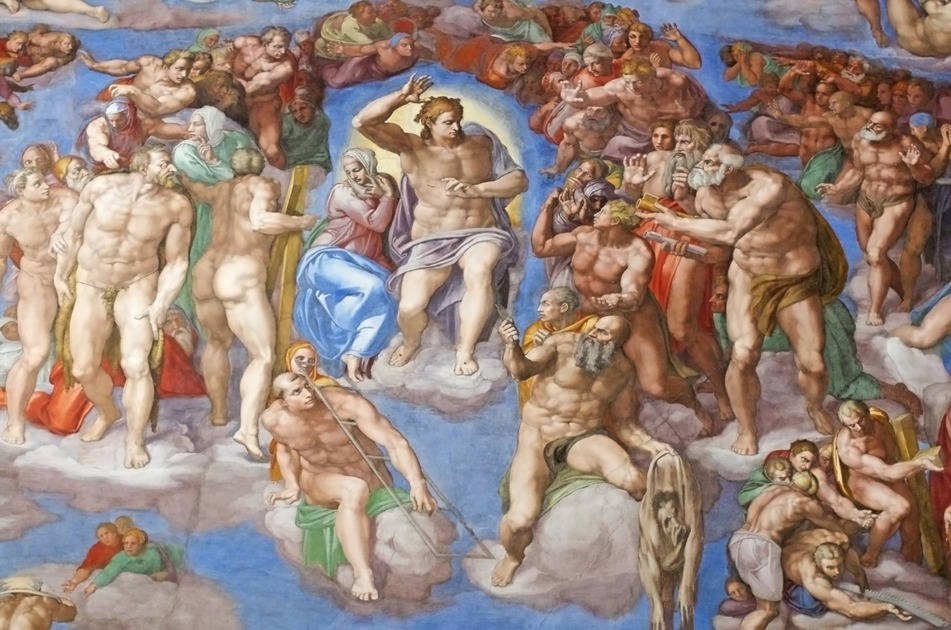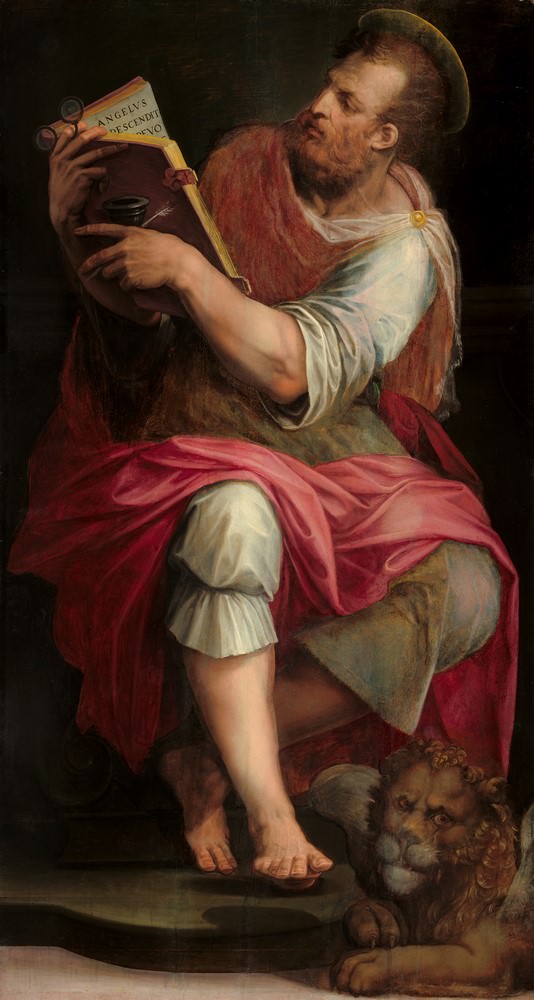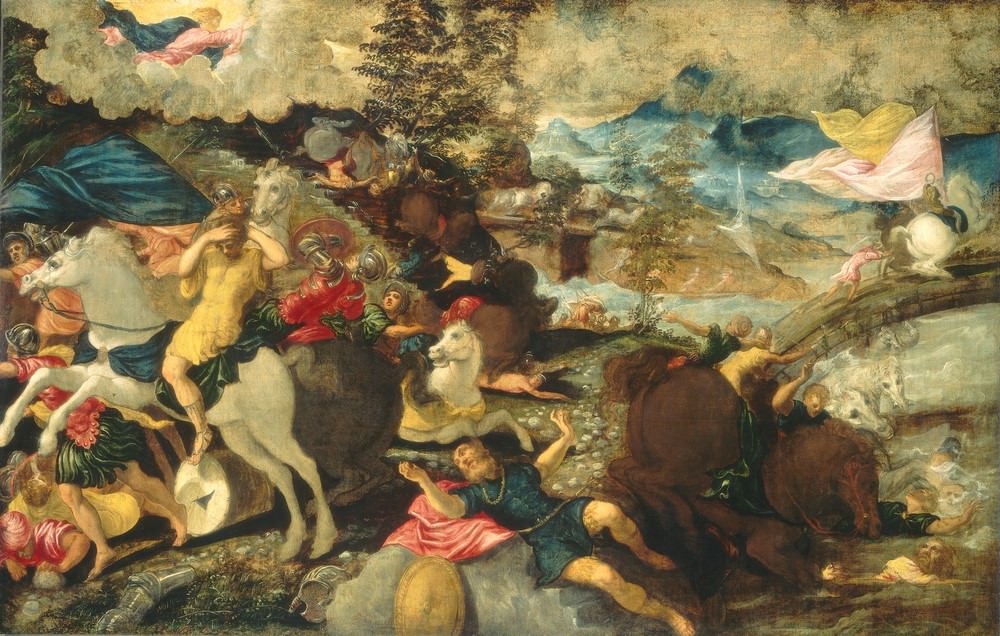You can also listen to this article in the voice of own Plastic Artist Rosângela Vig:

If I were a painter, would like to paint this last plan, the last landscape recess. But there was never a painter who could fix this mobile ocean, restless, uncertain, constantly variable that is the human thought? (MEIRELES, 1988, p.32)
The Renaissance aesthetic left the impression that the Art had reached a peak, in the matter of perfection and harmony. However, artists of the High Renaissance, such as Michelangelo (1475-1564) and Rafael (1483-1520) proved that there could still be na evolution and they broke the classic rules, leading the painting, to the movement and theatricality, as a rejection of the Renaissance balance.
The word Mannerism, derived from maneira, meant "style", or the way the artist expresses himself; the term used by Giorgio Vasari (1511-1574) to name the refined grace and lightness of this Art that flourished in the 16th century, in Rome and Florence in parallel with the Renaissance and which lasted until the early 17th century. The term came to be considered pejorative in the 18th century, as a decadent and affected Art. Even as the result of a decline of the Renaissance classical, the Mannerism, to some historians, was a transition between the Renaissance and the Baroque, for others, it was a style of its own.
The History
Mannerism arose as a reaction to the uncertainties of the 16th Century, a period marked by religious Reformists changes 1 and the Absolutism 2 in consolidation, in Europe. The Protestant Reformation, began in Germany, expanded to other countries, in the 16th century, and its main leader, the German Martin Luther. Although the movement was religious, caused changes in other sectors of European Culture, promoting the formation of Nation States, free of the Papal power. The Catholic Church, on the other hand, since the 15th century, aimed the spiritual strengthening, and reacted to the Reform movement, making the Counter-Reformation, in an attempt to regain strength. Art, in this sense, came again as a way to expand the Catholic power.
Although Mannerism is more related to events that occurred in Italy, it ended up influencing other European nations and even left traces in America and in the East.
The Architecture
Although the classic structure went into crisis, the traditional foundations also served as an anchor and was adjusted to the demands of society. The professional thinking, in Architecture, began to be explored in a new way and the problems relating to the construction began to be resolved in the very Architecture. The preference was for longer than wider spaces, with rectangular plant; versatility and diversification became visible in the construction of churches with large, longitudinal spaces; and the forms of light distribution, which is no longer centered.
In the churches, the style had the spiral stairs that did not lead anywhere and the whimsical decor with garlands, flowers and small columns rows, called balusters, resembling handrails. In the palaces, the beauty was due to the contrast of light and shadow; the richly adorned inside; and presentation of frescoes and vaults.
The Fontainebleau Castle 3 (Fig. 1), led to France the Italian Mannerism and became known as the School of Fontainebleau. In 1530, Francis I, fascinated by the Italian Art, hired the best painters and sculptors from Italy to reform the medieval castle. The French artists, who worked together with the Italians, eventually assimilate the trend. The mixed decoration, with paint, eventually spread throughout France and became known as the Fontainebleau Style. There are, in the decorative exuberance, frames that alternate with stucco and reliefs, in different ways, ornaments and woodwork, as well as sculptures that refer to the models of Michelangelo.

The Sculpture
Contemplate this splendor of Florentine graces;
Is that the ripple of muscular body,
Pulse strength and elegance, these divine sisters.
(BAUDELAIRE, 2006, p.33)
The exquisite features of the architecture echoed in the Sculpture. There was a preference by the appreciation of emotion and individual interpretations, which definitively broke the Renaissance harmony and caused uneasiness. There are remembrances of the Gothic style in the elongated figures and in the angles, with the difference of being dynamic and exhibit exaggerated movements. Among the attributes, are the capricious in strange proportions, mythological themes and the care of the details, suggesting a detachment from reality. The result of this combination was an elegant and original art.
Michelangelo's work marked the transition from the Renaissance to Mannerism and his style influenced the Italian Bartolomeo Ammannati (1511-1592). Giambologna (1529-1608), Flemish artist who probably was a collaborator of the works of Michelangelo, also turned out to assimilate the style. Among his works, are the numerous sources of the gardens of the Medici family, but his most famous work, The Rape of the Sabine (Fig. 2), shows the unmistakable mark of Mannerism. The work, carved from a single block of marble, is 4,10 meters of height, a detailed image with vivid demonstration of energy, in which a man is lifting a woman in the air, while another seems to be trying to rise, in a kind of passionate dispute. The sculptor knew how to explore gestures and movements brilliantly and created a scene that can be enjoyed and understood at various angles.

The Painting
The intelligence is sublime; the resourcefulness is beautiful; the audacity is great and sublime; cunning is small, but beautiful. (…) The truth and righteousness are simple and noble; Pun and obsequious flattery are thin and beautiful. Kindness is the beauty of virtue. The disinterested concern is noble. Courtesy and politeness are beautiful. The sublime qualities infuse respect; the Beautiful, love. (KANT, 1942, p.11)
The above quote draws a filing about Beauty, in Art. For Kant (1724-1804), to Sublime Art provokes, arouses the spirit; surprises; causes wonder. And maybe it is in the sphere of the Sublime Art, that the Mannerist style is justified, given the plans and unreal and unsettling scenarios of the Works. And it was on the field of Painting that the first manifestations of this shape emerged, by the hand of Michelangelo and Raphael, in their final works. Reality no longer met the artists who sought to value the free Art, investigating new possibilities.

This feature is undeniable, in the fresco painted by Michelangelo, on the altar wall of the Sistine Chapel, The Last Judgment (Fig. 3). With measures of 13,5 by 12,2 meters, the version of the artist to the Biblical passage of the second coming of Christ, was completed thirty years after the roof of the same chapel, with which it contrasts. While the ceiling, has the grandiosity spirit and balance, the Last Judgment presents a disturbing scene of the Judgement, in an unreal space, with angels blowing trumpets and with people in various poses twitching and writhing. The melancholy, the anguish, the pain and the fear show that their souls can ascend to Heaven or descend to hell. The Work came to be judged obscene by the Council of Trent and fabrics were painted on the private parts of the naked people.

The Florentine Pontormo (1494-1556/7) (Fig. 4), who studied with some of the Renaissance masters, such as, Leonardo Da Vinci, broke away from the Classical Art and created a personal style. His works, mostly with religious themes, show his unusual personality. The boldness and eroticism are exposed in the Work of another Florentine, Agnolo Bronzino (1503-1572) (Fig. 5), who was Pontormo's apprentice. The work, Allegory with Venus and Cupid, was commissioned by Cosimo de Medici Duke, as a gift to King Francis I, from the Court of Fontainebleau, in France, the Mannerist Center. Among the mythological elements, are Venus, the Goddess of Love, disarming her son, Cupid; Time, represented by an old man with an hourglass; Jealousy can be related to syphilis, a disease that was widespread at the time, both in Italy and in France. The scene was once considered immoral, was modified and then restored. It is worth remembering Giorgio Vasari (1511-1574) (Fig. 6), who, besides being a painter and an architect, had great prominence in Florence. In 1550 Vasari published the book Lives of the most Eminent Italian Architects, Painters and Sculptors and, in 1563, along with Bronzino, he created the Academia del Disegno, in Florence. Among the Italians, there are still other artists who joined the style, such as Alessandro Allori (1535-1607), the adopted son Bronzino, Rosso Fiorentino (1494-1540), Parmigianino (1503-1540), Pellegrino Tibaldi (1527-1596), Federico Barocci (around 1533-1612) and Tintoretto (1518-1594) (Fig. 7), known for its radicalism, in the Painting.

Outside Italy, the Mannerist Art was taken to France, initially through Fontainebleau and spread through the region, joining the Flemish Art, at the hands of artists such as Frans Floris (1517-1570), Jan Van Scorel (1495-1562) and Maerten van Heemskerck (1498-1574) and the Italian Niccolò dell'Abate (1509/12-1571) who worked in Fontainebleau. But the Mannerist exoticism was apparent in the works of El Greco (1541-1614). He earned the nickname of “The Greek” due to his birth in Crete, where he studied the Byzantine Art; in Venice, he probably worked in the studio of Titian, where he met the artists of Mannerism, such as, Tintoretto, who inspired him. The Burial of the Count of Orgaz 4,5 is among the most significant Works of El Greco, but Laocoon (Fig. 8), is one of the few mythological works by the artist, and it has clear marks of Mannerism, in the unmistakable elongated and tortuous figures. The scene tells the mythical story in which the Gods punish Laocoon and his sons, in a deadly struggle against menacing serpents. Two figures that watch the scene may represent the Gods themselves witnessing the punishment. Emphasizes the idea of horror and fear, the ghostly and astounding scenario, in which it’s not possible to understand the origin of light; There are people with strained and stiff bodies, with tight muscles, in a dramatic attempt to struggle. The city of Toledo, at the background of the image, amid all the tension of the scene, what can mean a reference to the Inquisition.

Final Considerations
Mannerism is the testimony that aesthetics is always in a transformation process, advancing in parallel with human thought, with his views on the world around, that is in a constant evolution. The move away from naturalism ended up directing the Art, to the styles that came next, the Baroque and the Rococo. But above all, what became clear is that the autonomy allowed the artists to surrender to emotions and to act independently. Schiller (2002, pages 21 and 22) was right when he said that "Art is the daughter of freedom and wants to be legislated by the laws of the spirit, not the deprivation of material." The ingenuity dared to change what was already considered the Beauty and perfect; the Aesthetics of the Renaissance, were incorporated to the movement, the aspirations and the anxieties of the period. The freedom opened the field for artists to demonstrate the essence of the soul and as a result, the Art History, won a splendid and intellectual model, distant from reality.
The Art is in nature – those able to extract it, to possess it.
(ALBRECHT DÜRER in WELTON, 2014, p.121)

1 Reformation and Counter-Reformation:
www.historianet.com.br/conteudo/default.aspx?codigo=918
2 Absolutism is a method or government doctrine where power is centered on a boss who takes all the decisions. His power is unlimited and unrestricted.
3 Fontainebleau Castle:
www.musee-chateau-fontainebleau.fr/The-Renaissance?lang=en
4 The Burial of the Count of Orgaz (1586/8), by Oscar D'Ambrosio, in Artcanal site:
artcanal.com.br
5 Link for the video on the Work The Burial of the Count of Orgaz (1586/8), by El Greco, at St. Thomas Church, Toledo (Spain):
www.santotome.org

The National Gallery of Art, Washington
Situated among the top ten world's Art Museums, the National Gallery is in Washington, USA and was founded in 1937. Andrew W. Mellon Fund, an art collector of Pittsburgh, donated a fund for the construction of the museum and his Art collection. Other collectors later, donated objects, which included Italian paintings, sculptures and porcelains. The intention was to form a National Art Gallery.
Sign up to receive Event News
and the Universe of Arts first!
Andrew Mellon chose, the architect John Russell Pope (1874-1937) for the new museum building project. As Mellon believed that visitors should not only learn, but enjoy the Art, through the collection, the works are displayed by period and by origin, in appropriately decorated galleries. In the galleries of the Renaissance, there are Italian wall coverings, hand finished plaster walls, full of details, with moldings on the doors and niches for the sculptures. Through an application for mobile devices, it is possible to visit the works, with audio comments about the artists and the periods, as well as important information about special museum exhibitions.
Link to the National Gallery, Washington: www.nga.gov/content/ngaweb/Collection.html

…
Liked? [highlight]Leave a comment[/highlight]!
References:
- BAUDELAIRE, Charles. As Flores do Mal. São Paulo: Editora Martin Claret, 2006. Tradução de Pietro Nassetti.
- BAYER, Raymond. História da Estética. Lisboa: Editorial Estampa, 1993. Tradução de José Saramago.
- CHILVERS, Ian; ZACZEK, Iain; WELTON, Jude; BUGLER, Caroline; MACK, Lorrie. História Ilustrada da Arte. Publifolha, S.Paulo, 2014.
- FARTHING, Stephen. Tudo Sobre a Arte. Rio de Janeiro: Sextante, 2011.
- GOMBRICH, E.H. A História da Arte. Rio de Janeiro: Editora Guanabara, 1988.
- HAUSER, Arnold. História Social da Arte e da Literatura. Martins Fontes, São Paulo, 2003.
- KANT, Immanuel. O Belo e o Sublime. Pôrto: Livraria Educação Nacional Ltda., 1942.
- MEIRELES, Cecília. Janela Mágica. São Paulo: Ed.Moderna, 1988.
- SCHILLER, Friedrich Von. A Educação Estética do homem. 4to. edição. S.Paulo: Ed. Iluminuras, 2002.
The figures:
Fig. 1 – Interior details of the Fontainebleau Castle, France.
Fig. 2 – The Rape of the Sabine Women, Giambologna, 1581-1582, Florence, Italy.
Fig. 3 – The Last Judgement, fresco in the Sistine Chapel, Michelangelo, 1536-41, Vatican, Italy.
Fig. 4 – Monsignor Della Casa, Pontormo, 1541-1544, National Gallery of Art, Washington. Samuel H. Kress Collection.
Fig. 5 – The Holy Family, Agnolo Bronzino, 1527-1528, National Gallery of Art, Washington. Samuel H. Kress Collection.
Fig. 6 – Saint Mark, Giorgio Vasari, 1570-157, National Gallery of Art, Washington.
Fig. 7 – The Convertion of Saint Paul, Jacopo Tintoretto, 1545, National Gallery of Art, Washington. Samuel H. Kress Collection.
Fig. 8 – Laocoön, El Greco, 1610-1614, National Gallery of Art, Washington. Samuel H. Kress Collection.
Fig. 9 – Madonna and Child, with Saint Martina e Saint Agnes, El Greco, 1597-1599, National Gallery of Art, Washington. Widener Collection.
You might also like:
- First Traces of Modern Art – Abstract Expressionism in Brazil by Rosângela Vig
- First Traces of Modern Art – Expressionism in Brazil by Rosângela Vig
- Modern Art – Abstract Expressionism by Rosângela Vig
- First Traces of Modern Art – Impressionism in Brazil by Rosângela Vig
- Modern Art – Surrealism by Rosângela Vig
- Modern Art – Abstractionism by Rosângela Vig
- Modern Art – Cubism by Rosângela Vig
- Modern Art – Expressionism by Rosângela Vig
- First Traces of Modern Art – Symbolism by Rosângela Vig
- First Traces of Modern Art – Post-Impressionism by Rosângela Vig
- First Traces of Modern Art – Impressionism by Rosângela Vig
- Romanticism in Brazil by Rosângela Vig
- Romanticism by Rosângela Vig
- The Neoclassical Art in Brazil by Rosângela Vig
- The Rococo in Brazil by Rosângela Vig
- The Neoclassical Art by Rosângela Vig
- Rococo by Rosângela Vig
- How appears the Surreal Work by Rosângela Vig
- The Baroque in Brazil by Rosângela Vig
- Baroque by Rosângela Vig
- Flemish Art – Renaissance in Northern Europe by Rosângela Vig
- Renaissance by Rosângela Vig
- The Contemporary, A little about the Urban Art by Rosângela Vig
- The Naive Art – Ingénue Art by Rosângela Vig
- Middle Ages, Byzantine Art by Rosângela Vig
- Middle Ages, Romanesque Art and Gothic Art by Rosângela Vig
- The Roman Art by Rosângela Vig
- Greek Art, Art History in Ancient Greece by Rosângela Vig
- The Egyptian Art by Rosângela Vig
- The Prehistoric Art by Rosângela Vig
- The beauty Art and the sublime Art by Rosângela Vig
- The Game of Art by Rosângela Vig
- The Misunderstood Art by Rosângela Vig
ROSÂNGELA VIG
Sorocaba – São Paulo
Facebook Profile | Facebook Fan Page | Website
Columnist at Website Obras de Arte
E-mail: rosangelavig@hotmail.com

Mannerism by Rosângela Vig | Website Obras de Arte
http://t.co/XnS11yxXIT Mannerism by Rosângela Vig
The Renaissance aesthetic left the impression that the Art had reached a peak, on the question of perfection and… http://t.co/rq4k6EEnBB
Mannerism by @VigRosangela
#art
http://t.co/XnS11yxXIT http://t.co/gj2bD5Cza7
History of art in the art site
Mannerism – Beautiful works. Breathtaking images… http://t.co/0L0grd5DJV
Mannerism by Rosângela Vig http://t.co/Fmdiffn3t7
@Obrasdartes beautiful style. The great masters have left us a story beautiful beautiful.
RT @ Obrasdartes: Mannerism by @VigRosangela
#art
http://t.co/XnS11yxXIT http://t.co/gj2bD5Cza7
@Obrasdartes belas imagens
Hello Flavio @Flaviomacedo20, You can check out the Mannerism?
https://t.co/XnS11yxXIT
@eli_nou Hi Eli, I would like to take a look at Mannerism?
https://t.co/XnS11yxXIT
@ajcampos01 Hi Antonio, already checked the mannerism?
https://t.co/XnS11yxXIT
Mannerism by Rosângela Vig https://t.co/Fmdiffn3t7